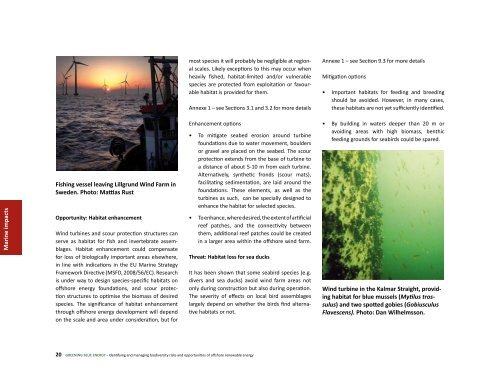Greening Blue Energy - BioTools For Business
Greening Blue Energy - BioTools For Business
Greening Blue Energy - BioTools For Business
You also want an ePaper? Increase the reach of your titles
YUMPU automatically turns print PDFs into web optimized ePapers that Google loves.
Marine impacts<br />
Fishing vessel leaving Lillgrund Wind Farm in<br />
Sweden. Photo: Mattias Rust<br />
Opportunity: Habitat enhancement<br />
Wind turbines and scour protection structures can<br />
serve as habitat for fish and invertebrate assemblages.<br />
Habitat enhancement could compensate<br />
for loss of biologically important areas elsewhere,<br />
in line with indications in the EU Marine Strategy<br />
Framework Directive (MSFD, 2008/56/EC). Research<br />
is under way to design species-specific habitats on<br />
offshore energy foundations, and scour protection<br />
structures to optimise the biomass of desired<br />
species. The significance of habitat enhancement<br />
through offshore energy development will depend<br />
on the scale and area under consideration, but for<br />
most species it will probably be negligible at regional<br />
scales. Likely exceptions to this may occur when<br />
heavily fished, habitat-limited and/or vulnerable<br />
species are protected from exploitation or favourable<br />
habitat is provided for them.<br />
Annexe 1 – see Sections 3.1 and 3.2 for more details<br />
Enhancement options<br />
• To mitigate seabed erosion around turbine<br />
foundations due to water movement, boulders<br />
or gravel are placed on the seabed. The scour<br />
protection extends from the base of turbine to<br />
a distance of about 5-10 m from each turbine.<br />
Alternatively, synthetic fronds (scour mats),<br />
facilitating sedimentation, are laid around the<br />
foundations. These elements, as well as the<br />
turbines as such, can be specially designed to<br />
enhance the habitat for selected species.<br />
• To enhance, where desired, the extent of artificial<br />
reef patches, and the connectivity between<br />
them, additional reef patches could be created<br />
in a larger area within the offshore wind farm.<br />
Threat: Habitat loss for sea ducks<br />
It has been shown that some seabird species (e.g.<br />
divers and sea ducks) avoid wind farm areas not<br />
only during construction but also during operation.<br />
The severity of effects on local bird assemblages<br />
largely depend on whether the birds find alternative<br />
habitats or not.<br />
20 GREENING BLUE ENERGY - Identifying and managing biodiversity risks and opportunities of offshore renewable energy<br />
Annexe 1 – see Section 9.3 for more details<br />
Mitigation options<br />
• Important habitats for feeding and breeding<br />
should be avoided. However, in many cases,<br />
these habitats are not yet sufficiently identified.<br />
• By building in waters deeper than 20 m or<br />
avoiding areas with high biomass, benthic<br />
feeding grounds for seabirds could be spared.<br />
Wind turbine in the Kalmar Straight, providing<br />
habitat for blue mussels (Mytilus trossulus)<br />
and two spotted gobies (Gobiusculus<br />
Flavescens). Photo: Dan Wilhelmsson.



